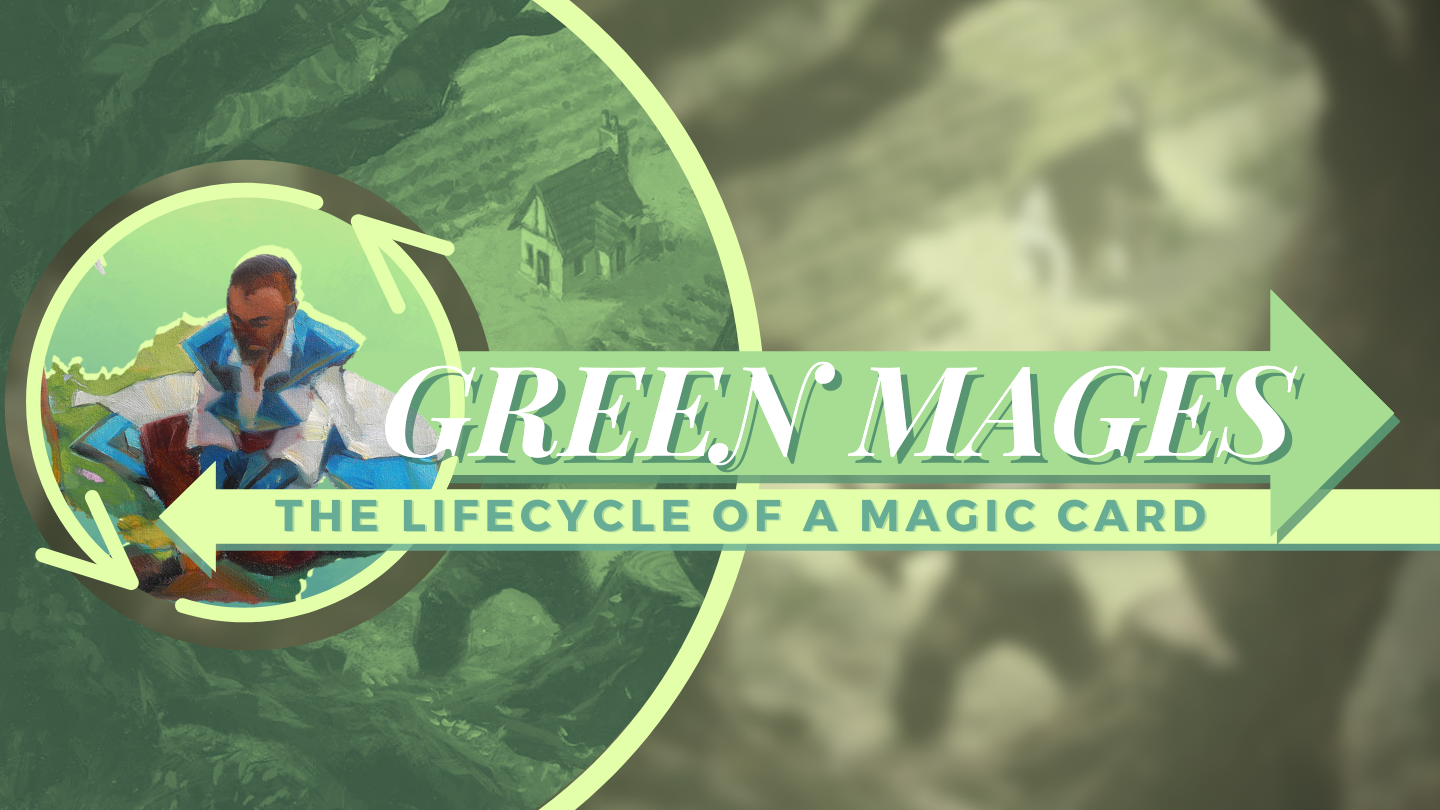Green Mages: The Lifecycle of a Magic Card

Welcome to Green Mages, an article series where we explore the intersection between two of my biggest passions: sustainability and Magic: The Gathering.
To me and millions of other fans, Magic is the greatest game in the world. Starting all the way back in 1993, Magic has grown into one of if not the biggest trading card game in the world. Each year, thousands of new cards are designed and printed, ever increasing the size and scope of this amazing game. At the click of a button or tap of the finger, we have access to hundreds of hours of carefully crafted content dedicated to every format we could dream of. New players are flocking to the game constantly thanks to the many avenues available to join the game, be it the digital game clients Arena or MTGO, preconstructed Commander decks available at most retail stores, or otherwise.
All of these things are amazing and exciting, but how many of us have stopped to ask the real question.
What Impact Does Magic: The Gathering Have On The Planet?
It might be easy to dismiss the need for such an exploration, as there are so many other industries that have a greater impact on the planet and whose efforts are crucial to our fight against climate change, but a total systems change requires everyone to participate, even the small players.
I believe that Magic: The Gathering can set the example for what a truly sustainable game can look like, but unless we as a community ask for it, we will never see that future achieved, which is why I'm writing in the first place: I want to see a change, and I'm sure many of you out there do, too! So join me as we explore what it truly looks like to be a "Green Mage".
Cradle to Grave
When working on the environmental sustainability of a consumer product, one of the most foundational steps you can take to understand the impact of your product is to undergo what is known as a life cycle analysis, or an LCA.
A LCA is a process where one tracks the full life of a good from its raw material (cradle) all the way through its life of manufacturing, distribution, intended use, and ultimately through its final disposal (grave) to understand the impact that the product has on the environment. Popularized in the 80s, the colloquial term for this process is known as "Cradle to Grave".
In this inaugural edition of Green Mages, it's important to go through a high-level LCA of the most core element of our game, the Magic card, and follow its journey from cradle to grave.
All Magic cards start off as trees. Sorry to all the non-green mages out there, but unfortunately all of your cards were at one point a forest. The trees are then cut down and transported, likely by a fossil-fuel-powered vehicle, to a paper mill where they are turned into a pulp and then eventually into the cardstock used for the cards themselves This is the first major step in the journey.
The impact numbers here are tricky because there can be a lot of variety between the weights of trees and the weights of paper, but the general consensus says that it takes anywhere from 8-24 trees to make a single ton of paper. Magic cards weigh about 1.8 grams, so to draw the comparison with 8-24 trees per ton of paper, that would equate to somewhere around 500,000 Magic cards.
The Journey Continues
On the next leg in the journey, the paper itself needs to be turned into an actual Magic card. Since the very beginning of the game, Magic cards have been printed by Cartamundi, a Belgium-based company that specializes in the manufacturing of playing and trading cards. For Magic, the most recent data shows that they print the cards in two main locations: Dallas and Belgium.
Once they have been printed, they get wrapped in a non-recyclable plastic wrapper (we will cover the packaging in more depth in a later entry in the series) and shipped out all across the world to begin their lives as fully functioning game pieces.
In their 2022 environmental report, Hasbro shared their carbon emissions data and cited using air, sea, and road transit for the distribution of their products. The impact of this transit is significant, especially if air transit is used. Air transit is 47 times more greenhouse-gas-intensive than ocean travel per ton mile. This step in the journey is the most environmentally intensive and makes up the bulk of the impact Magic has on the planet.

Once the cards have been moved all across the world, they enter the use stage of the product. This is where we all get to enjoy the massive amount of pleasure that the game brings us. We brew new decks, go to tournaments, and banter with friends, all motivated by the colorfully and beautifully crafted squares of cardboard that we all hold so dear.
But eventually, the love for our cards fades.
The Graveyard
Whether it's because we have grown bored of a deck, new cards have come to replace old staples, or we drift away from the game entirely, eventually all of our cards are destined for obsolescence.
As with most things in this world, it's not hard to imagine that, eventually, most Magic cards find their way to the landfill at the end of their life, and that path is easy to picture. I'm sure many of you reading right now have piles of Magic cards stacked around your home filled to the brim with draft chaff and rejected Commander cards that will never see the light of a game table again. When it comes time for spring cleaning, instead of sorting through them, they "Magic"ally find their way into a trashcan, never to be seen or worried about again. Those cards are then run through municipal trash programs and eventually end up in landfills where their grave ultimately lies, closing the lifecycle of the card.
But that doesn't need to be the case! There are many options for the end of life of your cards outside of the landfill.
A New Life
The first and best option is to find a new home for them. Magic cards, by design, are built to be very durable. They will last far beyond their gameplay relevance, so instead of throwing them out, give them a second life. Find a family friend that you think would enjoy the game and donate your cards to them! Or reach out to your local library or school system and ask if they run any after-school game programs and if they would be open to taking donations. Anything you can do to keep the cards in circulation and in use is the best thing you can do, environmentally, with your old cards. Re-use will always beat out all other options.
If you can't find a new home for your cards, the next best option is to recycle your cards. Outside of foils, according to Wizards, most curbside recycling programs can collect and process Magic cards. That's right, Magic cards can indeed be recycled, so if you need to get rid of your cards quickly, putting them in the recycling is your best bet. that paper will likely be reused and repurposed and given a new life. Paper can be recycled anywhere from 4 to 7 times, and since most Magic cards are made from virgin materials, there is plenty of life still in the cardstock to be reused.

In an ideal world, there would be a third option here: send them back to Hasbro.
In our modern economy, the blame for waste has been shifted to the consumer. In reality, waste should be managed by the company that manufactures the good, not the one who purchases the good. There is a deep history as to how this blame has been shifted (you can read about it more here), but the long and short of it is companies don't want to bear the weight of the cost for post-use waste management and have therefore organized to push that responsibility onto the consumer. I believe that if Hasbro wants to be a sustainability leader in the gaming world they should lead the charge by implementing a take-back program.
Instead of closing the life cycle of our cards by throwing them in the trash, let's work to give our Magic cards new life by getting them in new hands or at the very least getting them in the recycling bin to have a chance at a new life. Let's change the paradigm and try and make our game a greener and better place.
Thanks for joining me for the first installment of Green Mages here on Commander's Herald. Are there any topics relating to Magic and sustainability that you would like to read about? What creative ways have you given your Magic cards new life? Let me know in the comments below!